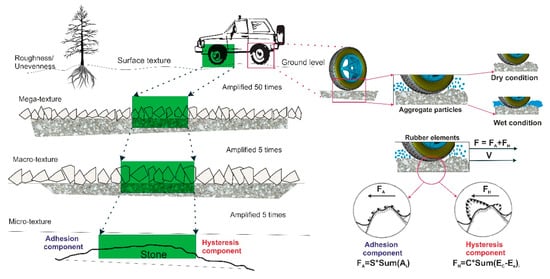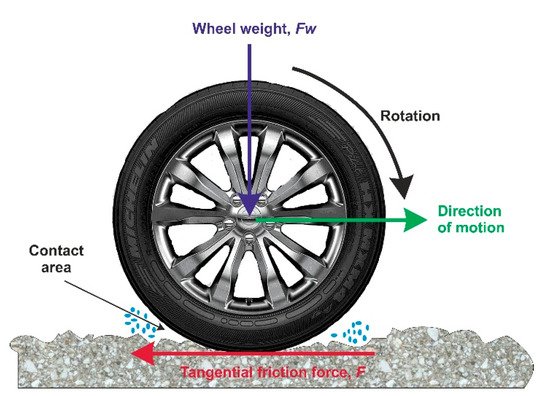Skid resistance is a significant feature that provides consistent traffic safety management for road pavements. An appropriate level of Skid resistance describes the contribution that the pavement surface makes to tire/road friction, and the surface of the road pavement can reduce vehicle operation cost, traffic accidents, and fatalities, particularly in wet conditions. Wet conditions decrease the level of the skid resistance (pavement friction), and this may lead to serious struggles related to driving on the road pavement (e.g., skidding or hydroplaning), which contributes to higher crash rates. The knowledge of skid resistance is essential to ensure reliable traffic management in transportation systems. Thus, a suitable methodology of skid resistance measurement and the understanding of the characterization of the road pavement are key to allow safe driving conditions.
- skid resistance
- infrastructure assessment
- road friction
- data analysis
- interoperability
- NDT
- road sensors
1. Introduction of Skid Resistance
1.1. Background
2. Factors Influencing Skid Resistance
| Road Surface Characteristics | Traffic Conditions | Vehicle Operations | Road Users | Tire Properties | Environmental Conditions |
|---|---|---|---|---|---|
| 1. Microtexture | 1. Traffic load | 1. Slip speed (SP) as a function of: | 1. Lack of knowledge about skid resistance reduction | Tread design and conditions | 1. Temperature (°C) |
| 2. Macrotexture | 2. Traffic density | 1.a. Vehicle speed, V | 2. Inattention | Inflation pressure | 2. Water content; |
| 3. Material characteristics | 3. Congestion | 1.b. Slip ratio % (G) | 3. Applied conditions of road pavement due to extreme weather conditions | Rubber configuration and rigidity | 2.a. Rainfall |
| 4. Megatexture | 1.c. Braking System | 4. Stopping distance | Footprint | 2.b. Condensation | |
| 5. Roughness/ unevenness |
1.d. Vehicle age | 5. Driving manoeuvre | Tire load | 3. Snow and ice/freezing conditions | |
| 6. Geometric of pavements | 1.e. Capacity of engine | 5.a. Turning | Tire temperature | 4. Contamination | |
| 6.a. Curves | 1.f. Suspension stability | 5.b. Overtaking | 4.a. Sand/dust | ||
| 6.b. Slopes | 1.g. Vehicle load | 4.b. Salt | |||
| 7. Temperature (°C) | 1.h. Electronic stability control | 4.c. Dirt | |||
| d. Mud | |||||
| 4.e. Organic materials | |||||
| 4.f. Organic debris | |||||
| 4.g. Rubber particles | |||||
| 4.h. Wind |
2.1. Category A: Pavement Surface Characteristics

| No. | Level of Texture | Wavelength, λ (mm) | Amplitude, A (mm) | Texture View |
|---|---|---|---|---|
| 1 | Micro-texture | 0 < λ < 0.5 | 0.001 < A < 0.5 |  |
| 2 | Macro-texture | 0.5 < λ < 50 | 0.1 < A <20 |  |
| 3 | Mega-texture | 50 < λ < 500 | 1 < A <50 |  |
| 4 | Roughness or unevenness | λ > 500 | 1 < A < 200 |  |
-
Microtexture is a fine-scale texture characteristic that is based on the surface properties of the asphalt mix, which include its size and shape, as well as the gradient of the aggregate, and on the asphalt/bitumen materials used to generate molecular adhesion (see Figure 4). The microtexture depends on the roughness of the aggregate surface [22][23]. It is considered to be one of the main features that can affect the skid resistance on the pavement surface. The level of texture of the microtexture is assumed according to its wavelength (0 < λ < 0.5) (measured in mm) and its amplitude (0.001 < A < 0.5) [6].
-
Macrotexture is a larger (coarse) scale texture characteristic, which is based on the existence of voids between aggregate particles and takes into account the larger size, shape, and gradient of the coarse aggregate in the asphalt mix. The macrotexture is the main characteristic that produces a loss of hysteresis (see Figure 4). Water can escape from channels at the macrotexture level of the surface pavement, thus decreasing hydroplaning. This texture level is assessed according to its wavelength (0.5 < λ < 50) (measured in mm) and its amplitude (0.1 < A <20) [12][21].
-
Megatexture is a texture that corresponds to the irregularities (e.g., distress, defects, or waviness) associated with rutting, potholes, patching, surface stone loss, and major joints and cracks in the road surface [22][23][24]. The megatexture influences the noise level and the rolling resistance more than the skid resistance of the road pavements. The texture level considered in this category is (50 < λ < 500) and (1 < A <50) in terms of wavelength and amplitude, respectively [12][24].
-
Roughness (unevenness) is a larger texture than the megatexture, and it can also influence the rolling resistance as well as the driving quality and the operation costs of the vehicles. Computing the overall measure of the surface pavement condition is usually based on the International Roughness Index (IRI). This texture level is (λ > 500) for wavelength and (1 < A < 200) for amplitude [22][23]
2.2. Category B: Traffic Conditions
2.3. Category C: Vehicle Operation Conditions
2.4. Category D: Road Users Behaviour
| No. | Pavement Condition | Skid Resistance | Vehicle Speed | Additional Causes or Extreme Conditions | Actions that Need to Be Taken by Road Users |
|---|---|---|---|---|---|
| 1 | Dry | High | Low | Normal dry condition |
|
| 2 | Wet | Low | High | Normal wet condition |
|
| 3 | Low | High | Tire age, or damaged tires (both wet and dry conditions) |
|
|
| 4 | Low | High | Curves, steep hills, edges, and junctions (both wet and dry conditions) |
|
|
| 5 | Low | High | Snow or Ice |
|
|
| 7 | Low | High | Contamination |
|
This entry is adapted from the peer-reviewed paper 10.3390/rs13183729
References
- AASHTO. Pavement Management Guide, 2nd ed.; AASHTO: Washington, DC, USA, 2012.
- Li, Q.J.; Zhan, Y.; Yang, G.; Wang, K.C.P. Pavement skid resistance as a function of pavement surface and aggregate texture properties. Int. J. Pavement Eng. 2020, 21, 1159–1169.
- Najafi, S.; Flintsch, G.W.; Khaleghian, S. Pavement friction management–artificial neural network approach. Int. J. Pavement Eng. 2019, 20, 125–135.
- Zhenning, L.; Yusheng, C.; Cong, C.; Guohui, Z.; Qiong, W.; Qian, Z.S.; Prevedouros, P.D.; Ma, D.T. Investigation of driver injury severities in rural single-vehicle crashes under rain conditions using mixed logit and latent class models. Accid. Anal. Prev. 2019, 124, 219–229.
- Åström, H.; Wallman, C.-G. Friction Measurement Methods and the Correlation between Road Friction and Traffic Safety. A Literature Review; Swedish National Rode and Transport Research Institute: Linköping, Sweden, 2001; p. 47.
- Ahammed, M.A.; Tighe, S.L. Asphalt pavements surface texture and skid resistance-Exploring the reality. Can. J. Civ. Eng. 2012, 39, 1–9.
- Snyder, M.B. Pavement Surface Characteristics a Synthesis and Guide; Skokie, A., Ed.; American Concrete Pavement Association: Skokie, IL, USA, 2006.
- Araujo, V.M.C.; Bessa, I.S.; Castelo Branco, V.T.F. Measuring skid resistance of hot mix asphalt using the aggregate image measurement system (AIMS). Constr. Build. Mater. 2015, 98, 476–481.
- Eurostat, 2018. Available online: https://ec.europa.eu/eurostat/statistics-explained/index.php?title=Road_accident_fatalities_-_statistics_by_type_of_vehicle (accessed on 9 September 2021).
- Ivan, J.N.; Ravishanker, N.; Jackson, E.; Aronov, B.; Guo, S. A Statistical Analysis of the Effect of Wet-Pavement Friction on Highway Traffic Safety. J. Transp. Saf. Secur. 2012, 4, 116–136.
- McGovern, C.; Rusch, P.; Noyce, D.A. State Practices to Reduce Wet Weather Skidding Crashes. U.S. Department of Transportation. 2011. Available online: https://rosap.ntl.bts.gov/view/dot/49268 (accessed on 9 September 2021).
- Pérez-Acebo, H.; Gonzalo-Orden, H.; Findley, D.J.; Rojí, E. A skid resistance prediction model for an entire road network. Constr. Build. Mater. 2020, 262, 120041.
- Highway Research Board. Skid Resistance. National Cooperative Highway Research Program. Synthesis of Highway Practice 14; Highway Research Board, National Academy of Sciences: Washington, DC, USA, 1972.
- Peng, Y.; Li, J.Q.; Zhan, Y.; Wang, K.C.; Yang, G. Finite Element Method-Based Skid Resistance Simulation Using In-Situ 3D Pavement Surface Texture and Friction Data. Materials 2019, 12, 3821.
- Hall, J.W. Guide for Pavement Friction; The National Academies Press: Washington, DC, USA, 2009.
- Kane, M.; Edmondson, V. Long-term skid resistance of asphalt surfacings and aggregates’ mineralogical composition: Generalisation to pavements made of different aggregate types. Wear 2020, 454, 203339.
- Cairney, P.T. ARRB Transport Research. In Skid Resistance and Crashes: A Review of the Literature; ARRB Transport Research, Limited.: Melbourne, Australia, 1997.
- Rith, M.; Kim, Y.K.; Lee, S.W. Characterization of long-term skid resistance in exposed aggregate concrete pavement. Constr. Build. Mater. 2020, 256, 119423.
- Pérez-Acebo, H.; Gonzalo-Orden, H.; Rojí, E. Skid resistance prediction for new two-lane roads. Proc. Inst. Civ. Eng. Transp. 2019, 172, 264–273.
- Khasawneh, M.A. Laboratory Study on the Frictional Properties of HMA Specimens Using a Newly Developed Asphalt Polisher. Int. J. Civ. Eng. 2017, 15, 1007–1017.
- Permanent International Association of Road Congresses (PIARC). Report of the Committee on Surface Characteristics. In Proceedings of the XVII World Road Congress, Brussels, Belgium, 13–19 September 1987.
- Jayawickrama, P.W.; Prasanna, R.; Senadheera, S.P. Survey of State Practices to Control Skid Resistance on Hot-Mix Asphalt Concrete Pavements. Transp. Res. Rec. 1996, 1536, 52–58.
- Widyatmoko, D.; Kingdom, U. The importance of Road Surface Texture in Active Safety Design and The Importance of Road Surface Texture in Active Road Safety Design and Assessment. In Proceedings of the International Conference Road Safety and Simulation (RSS2013), Rome, Italy, 22–25 October 2013.
- Meegoda, J.N.; Gao, S. Evaluation of pavement skid resistance using high speed texture measurement. J. Traffic Transp. Eng. 2015, 2, 382–390.
- Bazlamit, S.M.; Reza, F. Changes in asphalt pavement friction components and adjustment of skid number for temperature. J. Transp. Eng. 2005, 131, 470–476.
- Shafii, M.A. Skid Resistance and the Effect of Temperature; Universiti Teknologi Malaysia: Skudai, Malaysia, 2009.
- Rasol, M.A.; Pérez-Gracia, V.; Fernandes, F.M.; Pais, J.C.; Santos-Assunçao, S.; Santos, C.; Sossa, V. GPR laboratory tests and numerical models to characterize cracks in cement concrete specimens, exemplifying damage in rigid pavement. Measurement 2020, 158, 107662.
- Marecos, V.; Solla, M.; Fontul, S.; Antunes, V. Assessing the pavement subgrade by combining different non-destructive methods. Constr. Build. Mater. 2017, 135, 76–85.
- Rasol, M.A.; Pérez-Gracia, V.; Solla, M.; Pais, J.C.; Fernandes, F.M.; Santos, C. An experimental and numerical approach to combine Ground Penetrating Radar and computational modelling for the identification of early cracking in cement concrete pavements. NDT E Int. 2020, 115, 102293.
- Rasol, M. Development of New GPR Methodologies for Soil and Cement Concrete Pavement Assessment Mezgeen Abdulrahman Rasol Rasol; Polytechnic University of Catalonia (UPC): Barcelona, Spain, 2021.
- Rasol, M.A.; Pérez-Gracia, V.; Fernandes, F.M.; Pais, J.C.; Solla, M.; Santos, C. NDT assessment of rigid pavement damages with ground penetrating radar: Laboratory and field tests. Int. J. Pavement Eng. 2020, 1–16.

